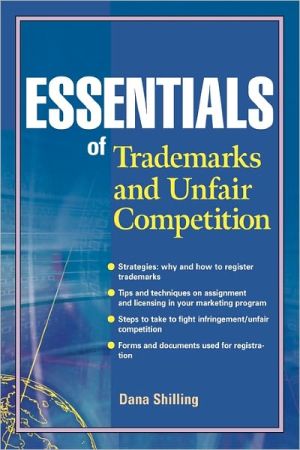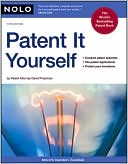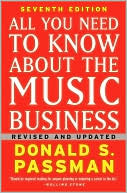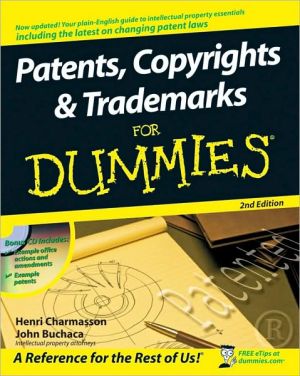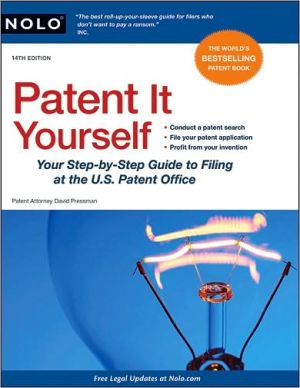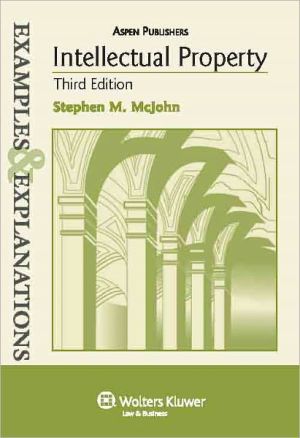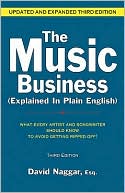Trademark Essentials
ESSENTIALS OF TRADEMARKS AND UNFAIR COMPETITION\ Full of valuable tips, techniques, illustrative real-world examples, exhibits, and best practices, this handy and concise paperback will help you stay up to date on the newest thinking, strategies, developments, and technologies in trademarks and unfair competition.\ "This is an extremely well-conceived, clearly written, and authoritative presentation of several related intellectual property disciplines. It will be valuable both to business...
Search in google:
ESSENTIALS OF TRADEMARKS AND UNFAIR COMPETITION Full of valuable tips, techniques, illustrative real-world examples, exhibits, and best practices, this handy and concise paperback will help you stay up to date on the newest thinking, strategies, developments, and technologies in trademarks and unfair competition. "This is an extremely well-conceived, clearly written, and authoritative presentation of several related intellectual property disciplines. It will be valuable both to business executives and nonspecialized lawyers. Serious readers should get up to speed rapidly because Ms. Shilling focuses on the real issues in an effective, user-friendly manner." —Robert Goldscheider, Chairman, The International Licensing Network "Dana Shilling has written a work that should be the new, first stop for junior associates or experienced general practitioners alike delving into their first serious engagement with the law of trademark and unfair competition. In a terse but accessible style she has touched on most of the major issues in these developing areas and has done so with a minimum of jargon, 'inside baseball,' and bias in an area rife with vested litigation and economic interests. No other book presently available fits quite this niche." —Ronald D. Coleman, Partner, Intellectual Property Department, Gibney, Anthony & Flaherty LLP The Wiley Essentials Series-because the business world is always changing...and so should you.
Essentials of Trademarks and Unfair Competition\ \ By Dana Shilling \ John Wiley & Sons\ ISBN: 0-471-20941-4 \ \ \ Chapter One\ Trademark Basics-Overview \ After reading this chapter you will be able to\ Understand why the legal system protects trademarks\ Identify trademarks\ Understand the scope of state and federal trademark laws\ Know how to use trademarks in commerce\ Compare trademarks to utility patents, design patents, and copyrights\ Trademarks have been used for centuries-probably as long as there has been more than one person carrying out a particular trade, or selling merchandise of a particular type, at the same market, or in the same town. An important part of business is developing a reputation for selling unusual merchandise, or for quality or variety of products, or for high value.\ A business can succeed only if customers buy its products or use its services. One of the most important functions of marketing and advertising is to create demand, not just for a particular type of product, but for the advertiser's or marketer's own goods. Trademarks (words, pictures, combinations of words and images, even sounds or fragrances) are important tools in identifying the business that provides the goods or services. A good trademark makes the product stand out.\ Because trademarks are such a key part of doing business, federal and state law protect a business's right to identify its own merchandise and to keep other people from counterfeiting merchandiseor using confusingly similar trademarks. However, the legal rules for trademarks (and the related concept of trade dress-the appearance and packaging of merchandise) are complicated and sometimes counterintuitive: they are not necessarily what a person in business would assume, based on experience in selling products. This book is designed to make confusing rules easier to understand.\ Focus of the Book\ This book covers a spectrum of related topics. Following the introduction of trademarks and trademark law in Chapters 1 and 2, the main concentration is on trademarks themselves. In addition, Chapter 2 touches on a large and growing group of issues: the difficult relationship between trademarks and the Internet, including but not limited to when trademarks can be used as URLs and when a cybersquatter can be punished for misuse of domain name registration. Note: Trademarks will be referred to in capital letter, such as COCA-COLA or NIKE.\ In many ways, the concepts of brand and trademark are closely related, although brand is a more modern and trademark a more traditional idea. But even though they are similar, they are not identical. Both of them involve product image and goodwill, but the concept of trademark focuses on the source of the goods.\ A consumer might have very high awareness of brand-might, for instance, have a shopping list that contains JIF peanut butter, ARRID EXTRA-DRY deodorant, DEL MONTE canned vegetables, CAMPBELL's canned soups, CREST toothpaste, and so on. This consumer might have a strong preference for these brands, based on a belief in their superior quality and attractiveness, and might take a rain check rather than purchase a competing brand, yet have no knowledge or interest in who manufactured the preferred brands. In fact, in today's business climate, where mergers and product divestitures are common, a brand might have been owned by several companies. Thus, the brand does not provide proof of source. In this book, we focus on the concepts of trademark.\ Chapter 3 covers how to search to see if a desired trademark is available, and how to register a trademark. Chapter 4 discusses what to do in case of an allegation of trademark infringement or if the trademark owner believes that the trademark has been infringed. The subjects of service marks and trade dress are addressed in Chapter 5.\ Chapter 6 covers threats to trademarks. However, a trademark is only one form of intellectual property. In the current business climate, businesses are becoming more and more aware of the importance of trademarks, trade secrets, patents and design patents, copyrights, and digital media assets to business success. The rules affecting these forms of intellectual property can be complex and overlapping. Inventing, manufacturing, and marketing a product can involve multiple forms of intellectual property, each with its own legal consequences. These issues are addressed in Chapter 7.\ In addition to trademarks and related subjects, this book also covers the law of unfair competition in business, because other forms of unfair business practice can overlap with trademark infringement. Chapter 8 tackles this subject.\ For your convenience, the book closes with several appendices and legal forms. When used in conjuction with the information presented in this text, the end material should equip you with the essential concepts you need in handling trademark issues.\ Sources of Trademark Law\ Trademark law was already in existence in England when the American Revolution occurred, and many of those concepts were adopted as U.S. law evolved. Merely using a trademark in commerce creates some protectable rights against unfair competition and imitation of the trademark. This is known as a common law trademark; the rights that arise are limited to the geographic area in which the mark is being used.\ However, as described in detail in this book, registering a trademark (with the state, the federal Patent and Trademark Office, or both) is often worthwhile because it increases the rights of the registrant against a trademark infringer. Remedies for trademark infringement can include injunctions, seizure of infringing or counterfeit merchandise, and money damages: see Chapter 4.\ Once a trademark is registered, it will become part of a large standard database that is open to the public. The practical effect is that businesses that are contemplating the use of a new trademark can search the database (see page 53) and discover if it is already in use, or if it might be considered confusingly similar to a trademark already in existence. The legal effect is that once a trademark is registered, or even published for objections (see page 70), everyone is deemed to have knowledge of it, and can be held responsible for the knowledge.\ Once a trademark is registered with the federal Patent and Trademark Office (PTO), the symbol (r) can be used in connection with the trademark. Any registered trademark, on either the Principal or the Supplemental Register, can use this symbol.\ Any trademark, registered or not, can be identified with the symbol (tm). This symbol just indicates that trademark rights have been asserted in the mark, not that any government agency has approved or registered the mark.\ Another advantage of registering a trademark is that, five years after a trademark has been registered, the general rule is that it will become incontestable-that is, no one will be allowed to bring a legal challenge to the validity of the trademark.\ However, the law contains a list of exceptions. A trademark can be challenged even after five years if it was obtained fraudulently, if the trademark owner has abandoned it (has stopped using it in commerce), and if the trademark has become generic-that is, if it is used to identify a whole class of products rather than the products of a specific company.\ State Trademark Law\ All of the states have some trademark and unfair competition laws of their own. In other words, even though patent law is considered so purely federal that states are not allowed to operate in this area, trademark law is shared by both the state and federal systems.\ State trademark laws tend to come into play when a trademark is used purely locally, not nationwide or in a multistate area, or if a trademark is of a type that is not eligible for listing on the federal Principal Register (see page 82).\ In general, state trademark law doesn't create a presumption that the trademark is valid, and doesn't make trademarks incontestable after a five-year period, the way federal law does.\ Model State Trademark Bill\ Forty-six states have adopted the Model State Trademark Bill (MSTB), which specifies how trademarks and service marks can be registered. Under the MSTB, radio and TV program titles and character names can be registered as service marks.\ The MSTB provides that a mark is "in use" when it is used in ordinary business; token transactions to reserve a mark don't count. Like federal law, the MSTB calls for marks to be placed on the goods, their containers, their displays, or tags or labels attached to the goods. The mark is supposed to be used on sales documentation for bulk goods or other items to which marks cannot be affixed. Service marks are to be displayed in sale or advertising or services.\ The MSTB, like the Lanham Act, discussed later, denies registration to marks that are immoral, deceptive, scandalous, or disapraging to individuals, that are just descriptive or misdescriptive (geographically or otherwise), or that are primarily merely a last name-unless the last name has become distinctive through use in commerce.\ To preserve the right of publicity (see page 203), the MSTB does not permit registration of a mark that consists of or includes a living person's name, signature, or portrait, unless the person has given consent.\ The term of protection under the MSTB is five years from the date of registration; it can be renewed an indefinite number of times, for five years at a time, by filing a renewal request within six months before the expiration of the term.\ If a second trademark is used that is confusingly similar to an existing trademark, the holder of the first trademark is entitled to get an injunction on the basis of unfair competition that will require the second trademark to be taken out of use. The confusingly similar trademark is subject to cancellation, and holders of the original trademark can get damages for trademark infringement and dilution. Dilution is imitating a trademark in a way that makes it less valuable by making potential customers associate inferior merchandise with the trademark.\ Under the MSTB, trademarks are considered abandoned either when there has been a two-year period without use of the trademark or the registrant of the mark stops using it and intends never using it again. Abandonment also occurs when the mark becomes generic or otherwise is no longer used as a trademark.\ Trademarks can be canceled for the following reasons:\ The trademark holder voluntarily requests its cancellation.\ A court holds that the mark has been abandoned.\ A court holds that the registrant doesn't really own the mark.\ There was fraud or other impropriety in the securing of the registration.\ The mark is confusingly similar to another mark.\ The mark has become generic.\ Federal Trademark Laws\ However, the most significant laws governing trademarks (and most other forms of intellectual property) are federal. The central statute covering trademarks is a federal law called the Lanham Act. The Lanham Act is a federal law, passed (and occasionally amended) by Congress. The federal agency responsible for administering federal trademark law is the Patent and Trademark Office (PTO). The PTO's regulations can be found in the Code of Federal Regulations (CFR).\ Amendments to the Lanham Act include the Trademark Revision Act of 1988 and more recent laws banning cybersquatting (improper practices involving registration of Internet domain names) and counterfeiting of trademarked merchandise-for example, imitations of Louis Vuitton handbags.\ The Lanham Act protects trademarks (as well as related types of marks such as service, collective, and certification marks) that are "used in commerce." At first, the Lanham Act protected only trademarks that had already been put into use. However, under current law, a trademark can be registered and protected on the basis of intent to use it in the future. For instance, it can be used in connection with a product that is under development and will be released in the future. This is known as an intent to use (ITU) application.\ The final registration will not be granted until the intention to use matures and turns into actual use. The applicant has to update the application by submitting a verified statement and specimens proving that the mark has been placed in actual use in interstate or foreign commerce. Depending on the time when it is filed, the appropriate form is either an Amendment to Allege Use (AAU) or a Statement of Use (SOU).\ Lanham Act §32(1)\ A person who has registered a trademark has the right to bring a civil suit against anyone who does one of two things without the consent of the registrant:\ 1. The infringer uses in commerce any "reproduction, counterfeit, copy or colorable imitation" of a registered mark in business, if such use is "likely to cause confusion, or to cause mistake, or to deceive." (The provision about "colorable imitations" is there to make sure that infringers can't make tiny changes in the mark and then use that as a defense against a §32(1) lawsuit.)\ 2. The infringer reproduces, counterfeits, copies, or "colorably imitates" a registered mark, and then applies the nonlegitimate mark to "labels, signs, prints, packages, wrappers, receptacles or advertisements" used in trade, once again if the likely result is confusion, mistake, or deception.\ The difference between these two very similar-sounding provisions is that the trademark holder can only get an award of damages or lost profits in a case of the second type if the infringer committed its acts with knowledge that the imitation is intended to be confusing or deceptive. It is not necessary to prove that the infringer's intentions were wrongful to win a case of the first type.\ Lanham Act §43(a)\ The Lanham Act also forbids a very broad range of unfair or inappropriate conduct that could cause consumer confusion-even if there are no registered trademarks involved.\ Section 43(a), which is often used in trade dress and false advertising cases, allows a civil suit to be brought by "any person who believes that he or she is or is likely to be damaged by such act." The forbidden acts are\ Use of words, symbols, devices, etc. (including combinations)\ False designation of origin\ False or misleading description of fact\ False or misleading representation of fact, either "on or in connection with any goods or services" or any "container," if the wrongful act occurs in "commerce."\ \ Continues...\ \ \ \ Excerpted from Essentials of Trademarks and Unfair Competition by Dana Shilling Excerpted by permission.\ All rights reserved. No part of this excerpt may be reproduced or reprinted without permission in writing from the publisher.\ Excerpts are provided by Dial-A-Book Inc. solely for the personal use of visitors to this web site. \ \
1Trademark Basics--Overview12Trademark Types213Establishing, Registering, and Defending a Trademark494Handling Trademark Disputes995Trade Dress1236Threats to the Trademark1377Other Issues in Trademark Law1538Unfair Competition191Appendices207Forms223Bibliography269Index271
